Ontario, OH Map & Demographics
Ontario Map
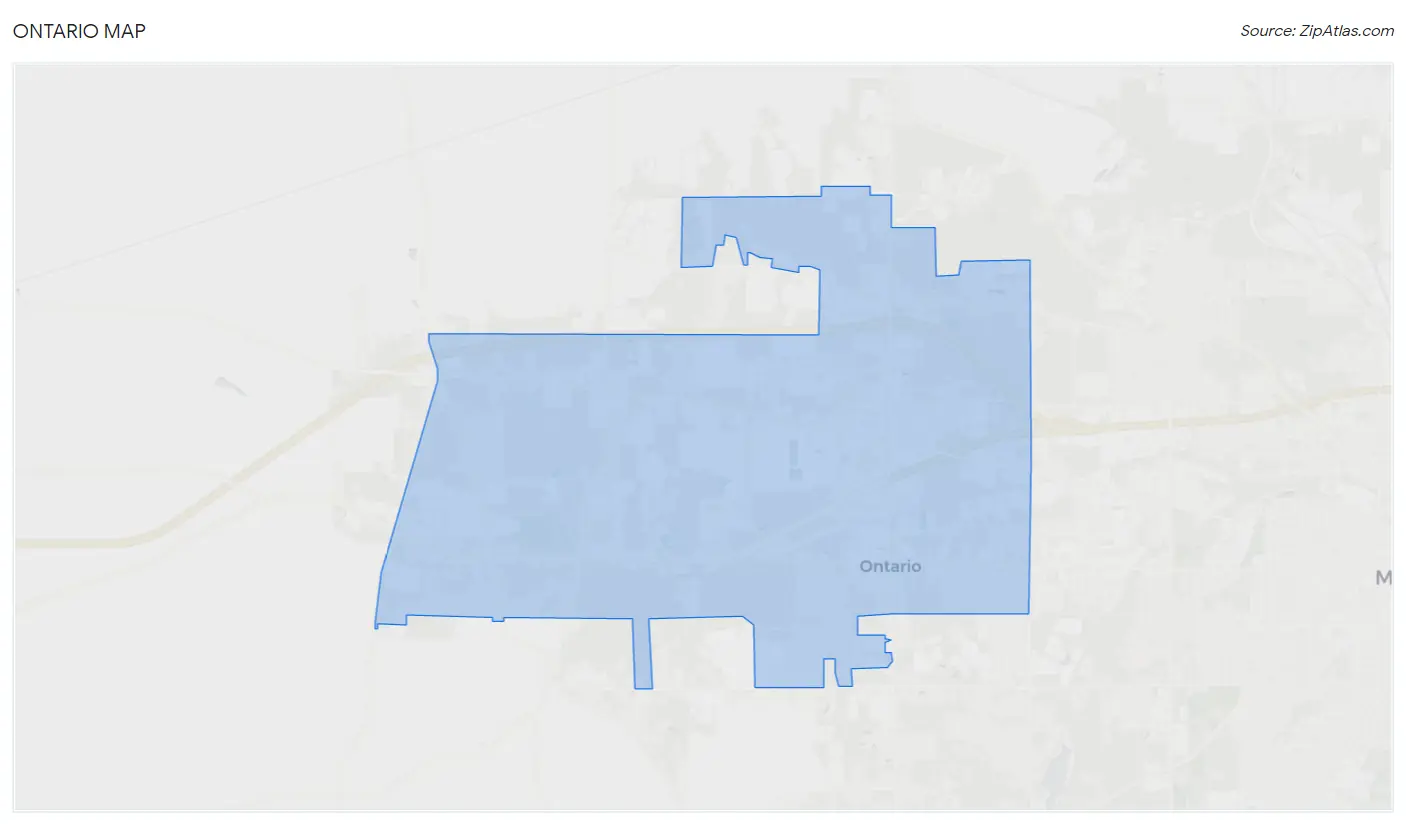
Ontario Overview
$34,613
PER CAPITA INCOME
$81,672
AVG FAMILY INCOME
$62,313
AVG HOUSEHOLD INCOME
43.4%
WAGE / INCOME GAP [ % ]
56.6¢/ $1
WAGE / INCOME GAP [ $ ]
0.44
INEQUALITY / GINI INDEX
6,642
TOTAL POPULATION
3,353
MALE POPULATION
3,289
FEMALE POPULATION
101.95
MALES / 100 FEMALES
98.09
FEMALES / 100 MALES
47.4
MEDIAN AGE
2.9
AVG FAMILY SIZE
2.4
AVG HOUSEHOLD SIZE
3,837
LABOR FORCE [ PEOPLE ]
68.7%
PERCENT IN LABOR FORCE
4.9%
UNEMPLOYMENT RATE
Income in Ontario
Income Overview in Ontario
Per Capita Income in Ontario is $34,613, while median incomes of families and households are $81,672 and $62,313 respectively.
| Characteristic | Number | Measure |
| Per Capita Income | 6,642 | $34,613 |
| Median Family Income | 1,809 | $81,672 |
| Mean Family Income | 1,809 | $89,778 |
| Median Household Income | 2,781 | $62,313 |
| Mean Household Income | 2,781 | $79,526 |
| Income Deficit | 1,809 | $0 |
| Wage / Income Gap (%) | 6,642 | 43.40% |
| Wage / Income Gap ($) | 6,642 | 56.60¢ per $1 |
| Gini / Inequality Index | 6,642 | 0.44 |
Earnings by Sex in Ontario
Average Earnings in Ontario are $35,974, $45,817 for men and $25,933 for women, a difference of 43.4%.

| Sex | Number | Average Earnings |
| Male | 2,104 (53.5%) | $45,817 |
| Female | 1,831 (46.5%) | $25,933 |
| Total | 3,935 (100.0%) | $35,974 |
Earnings by Sex by Income Bracket in Ontario
The most common earnings brackets in Ontario are $45,000 to $49,999 for men (303 | 14.4%) and $15,000 to $17,499 for women (181 | 9.9%).
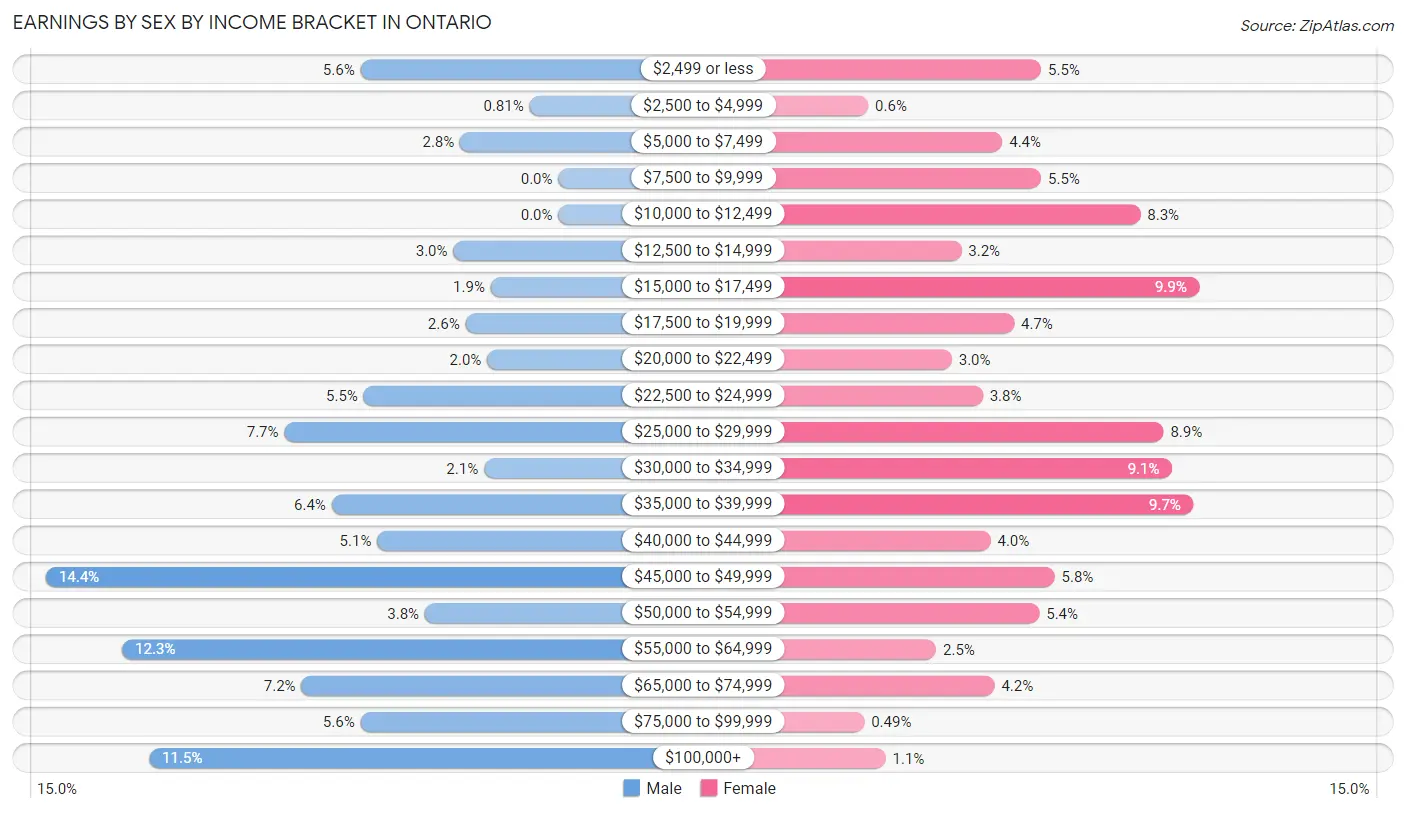
| Income | Male | Female |
| $2,499 or less | 117 (5.6%) | 100 (5.5%) |
| $2,500 to $4,999 | 17 (0.8%) | 11 (0.6%) |
| $5,000 to $7,499 | 58 (2.8%) | 80 (4.4%) |
| $7,500 to $9,999 | 0 (0.0%) | 100 (5.5%) |
| $10,000 to $12,499 | 0 (0.0%) | 151 (8.3%) |
| $12,500 to $14,999 | 62 (2.9%) | 59 (3.2%) |
| $15,000 to $17,499 | 40 (1.9%) | 181 (9.9%) |
| $17,500 to $19,999 | 55 (2.6%) | 86 (4.7%) |
| $20,000 to $22,499 | 42 (2.0%) | 54 (2.9%) |
| $22,500 to $24,999 | 115 (5.5%) | 70 (3.8%) |
| $25,000 to $29,999 | 162 (7.7%) | 163 (8.9%) |
| $30,000 to $34,999 | 44 (2.1%) | 167 (9.1%) |
| $35,000 to $39,999 | 134 (6.4%) | 178 (9.7%) |
| $40,000 to $44,999 | 107 (5.1%) | 74 (4.0%) |
| $45,000 to $49,999 | 303 (14.4%) | 107 (5.8%) |
| $50,000 to $54,999 | 79 (3.7%) | 99 (5.4%) |
| $55,000 to $64,999 | 258 (12.3%) | 46 (2.5%) |
| $65,000 to $74,999 | 152 (7.2%) | 76 (4.2%) |
| $75,000 to $99,999 | 117 (5.6%) | 9 (0.5%) |
| $100,000+ | 242 (11.5%) | 20 (1.1%) |
| Total | 2,104 (100.0%) | 1,831 (100.0%) |
Earnings by Sex by Educational Attainment in Ontario
Average earnings in Ontario are $47,108 for men and $27,103 for women, a difference of 42.5%. Men with an educational attainment of graduate degree enjoy the highest average annual earnings of $65,658, while those with college or associate's degree education earn the least with $46,015. Women with an educational attainment of graduate degree earn the most with the average annual earnings of $47,800, while those with high school diploma education have the smallest earnings of $21,974.

| Educational Attainment | Male Income | Female Income |
| Less than High School | - | - |
| High School Diploma | $53,654 | $21,974 |
| College or Associate's Degree | $46,015 | $26,917 |
| Bachelor's Degree | $60,259 | $38,288 |
| Graduate Degree | $65,658 | $47,800 |
| Total | $47,108 | $27,103 |
Family Income in Ontario
Family Income Brackets in Ontario
According to the Ontario family income data, there are 441 families falling into the $75,000 to $99,999 income range, which is the most common income bracket and makes up 24.4% of all families. Conversely, the $10,000 to $14,999 income bracket is the least frequent group with only 20 families (1.1%) belonging to this category.

| Income Bracket | # Families | % Families |
| Less than $10,000 | 81 | 4.5% |
| $10,000 to $14,999 | 20 | 1.1% |
| $15,000 to $24,999 | 67 | 3.7% |
| $25,000 to $34,999 | 33 | 1.8% |
| $35,000 to $49,999 | 248 | 13.7% |
| $50,000 to $74,999 | 302 | 16.7% |
| $75,000 to $99,999 | 441 | 24.4% |
| $100,000 to $149,999 | 393 | 21.7% |
| $150,000 to $199,999 | 118 | 6.5% |
| $200,000+ | 107 | 5.9% |
Family Income by Famaliy Size in Ontario
4-person families (290 | 16.0%) account for the highest median family income in Ontario with $110,658 per family, while 2-person families (961 | 53.1%) have the highest median income of $39,045 per family member.

| Income Bracket | # Families | Median Income |
| 2-Person Families | 961 (53.1%) | $78,090 |
| 3-Person Families | 458 (25.3%) | $100,600 |
| 4-Person Families | 290 (16.0%) | $110,658 |
| 5-Person Families | 84 (4.6%) | $62,303 |
| 6-Person Families | 16 (0.9%) | $0 |
| 7+ Person Families | 0 (0.0%) | $0 |
| Total | 1,809 (100.0%) | $81,672 |
Family Income by Number of Earners in Ontario
The median family income in Ontario is $81,672, with families comprising 3+ earners (242) having the highest median family income of $133,670, while families with no earners (291) have the lowest median family income of $38,692, accounting for 13.4% and 16.1% of families, respectively.

| Number of Earners | # Families | Median Income |
| No Earners | 291 (16.1%) | $38,692 |
| 1 Earner | 512 (28.3%) | $72,500 |
| 2 Earners | 764 (42.2%) | $84,332 |
| 3+ Earners | 242 (13.4%) | $133,670 |
| Total | 1,809 (100.0%) | $81,672 |
Household Income in Ontario
Household Income Brackets in Ontario
With 498 households falling in the category, the $50,000 to $74,999 income range is the most frequent in Ontario, accounting for 17.9% of all households. In contrast, only 28 households (1.0%) fall into the $10,000 to $14,999 income bracket, making it the least populous group.

| Income Bracket | # Households | % Households |
| Less than $10,000 | 128 | 4.6% |
| $10,000 to $14,999 | 28 | 1.0% |
| $15,000 to $24,999 | 353 | 12.7% |
| $25,000 to $34,999 | 217 | 7.8% |
| $35,000 to $49,999 | 392 | 14.1% |
| $50,000 to $74,999 | 498 | 17.9% |
| $75,000 to $99,999 | 492 | 17.7% |
| $100,000 to $149,999 | 431 | 15.5% |
| $150,000 to $199,999 | 117 | 4.2% |
| $200,000+ | 128 | 4.6% |
Household Income by Householder Age in Ontario
The median household income in Ontario is $62,313, with the highest median household income of $78,438 found in the 25 to 44 years age bracket for the primary householder. A total of 620 households (22.3%) fall into this category. Meanwhile, the 65+ years age bracket for the primary householder has the lowest median household income of $53,565, with 847 households (30.5%) in this group.

| Income Bracket | # Households | Median Income |
| 15 to 24 Years | 154 (5.5%) | $64,833 |
| 25 to 44 Years | 620 (22.3%) | $78,438 |
| 45 to 64 Years | 1,160 (41.7%) | $59,865 |
| 65+ Years | 847 (30.5%) | $53,565 |
| Total | 2,781 (100.0%) | $62,313 |
Poverty in Ontario
Income Below Poverty by Sex and Age in Ontario
With 6.0% poverty level for males and 8.6% for females among the residents of Ontario, 6 to 11 year old males and 6 to 11 year old females are the most vulnerable to poverty, with 48 males (13.9%) and 33 females (33.3%) in their respective age groups living below the poverty level.
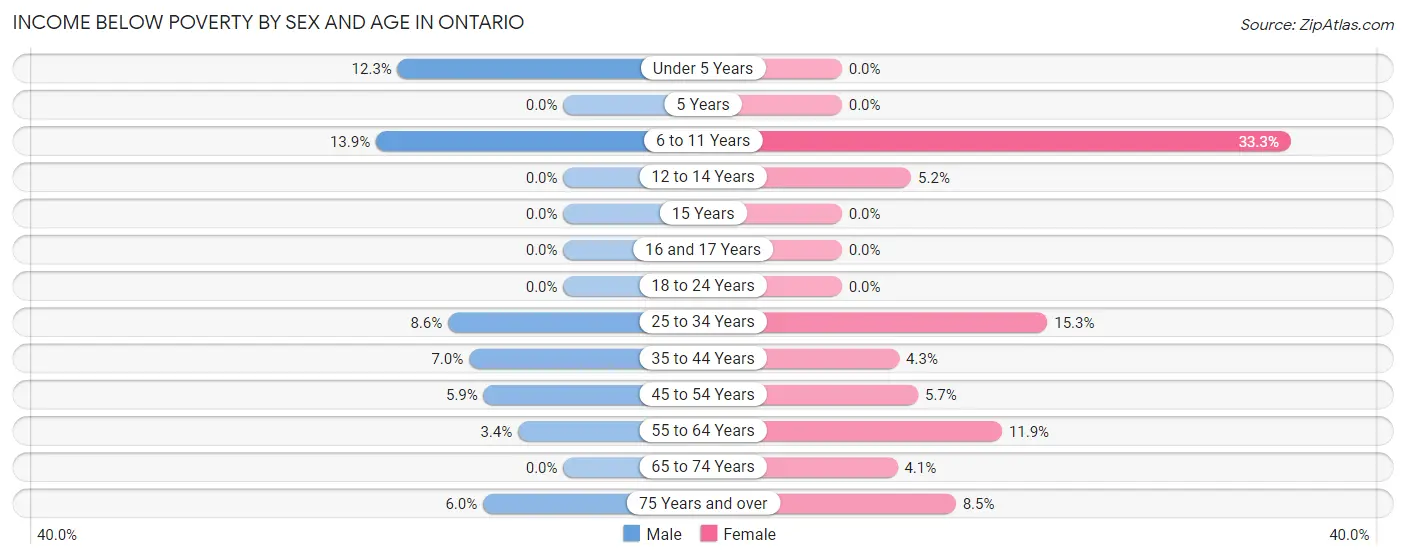
| Age Bracket | Male | Female |
| Under 5 Years | 30 (12.3%) | 0 (0.0%) |
| 5 Years | 0 (0.0%) | 0 (0.0%) |
| 6 to 11 Years | 48 (13.9%) | 33 (33.3%) |
| 12 to 14 Years | 0 (0.0%) | 5 (5.1%) |
| 15 Years | 0 (0.0%) | 0 (0.0%) |
| 16 and 17 Years | 0 (0.0%) | 0 (0.0%) |
| 18 to 24 Years | 0 (0.0%) | 0 (0.0%) |
| 25 to 34 Years | 32 (8.6%) | 65 (15.3%) |
| 35 to 44 Years | 31 (7.0%) | 8 (4.3%) |
| 45 to 54 Years | 29 (5.9%) | 24 (5.7%) |
| 55 to 64 Years | 15 (3.4%) | 97 (11.9%) |
| 65 to 74 Years | 0 (0.0%) | 16 (4.1%) |
| 75 Years and over | 17 (6.0%) | 28 (8.5%) |
| Total | 202 (6.0%) | 276 (8.6%) |
Income Above Poverty by Sex and Age in Ontario
According to the poverty statistics in Ontario, males aged 5 years and females aged under 5 years are the age groups that are most secure financially, with 100.0% of males and 100.0% of females in these age groups living above the poverty line.
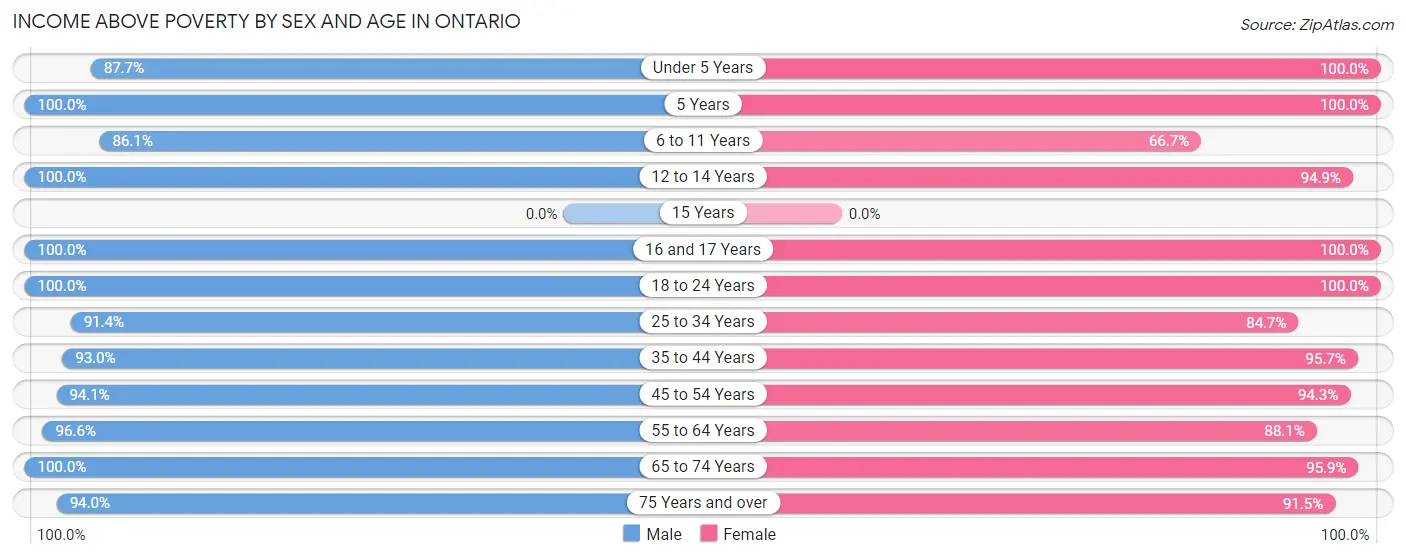
| Age Bracket | Male | Female |
| Under 5 Years | 214 (87.7%) | 122 (100.0%) |
| 5 Years | 22 (100.0%) | 49 (100.0%) |
| 6 to 11 Years | 297 (86.1%) | 66 (66.7%) |
| 12 to 14 Years | 79 (100.0%) | 92 (94.9%) |
| 15 Years | 0 (0.0%) | 0 (0.0%) |
| 16 and 17 Years | 71 (100.0%) | 44 (100.0%) |
| 18 to 24 Years | 328 (100.0%) | 209 (100.0%) |
| 25 to 34 Years | 342 (91.4%) | 361 (84.7%) |
| 35 to 44 Years | 412 (93.0%) | 180 (95.7%) |
| 45 to 54 Years | 461 (94.1%) | 400 (94.3%) |
| 55 to 64 Years | 432 (96.6%) | 719 (88.1%) |
| 65 to 74 Years | 225 (100.0%) | 371 (95.9%) |
| 75 Years and over | 268 (94.0%) | 303 (91.5%) |
| Total | 3,151 (94.0%) | 2,916 (91.3%) |
Income Below Poverty Among Married-Couple Families in Ontario
The poverty statistics for married-couple families in Ontario show that 1.9% or 29 of the total 1,547 families live below the poverty line. Families with 1 or 2 children have the highest poverty rate of 7.2%, comprising of 29 families. On the other hand, families with no children have the lowest poverty rate of 0.0%, which includes 0 families.

| Children | Above Poverty | Below Poverty |
| No Children | 1,046 (100.0%) | 0 (0.0%) |
| 1 or 2 Children | 372 (92.8%) | 29 (7.2%) |
| 3 or 4 Children | 100 (100.0%) | 0 (0.0%) |
| 5 or more Children | 0 (0.0%) | 0 (0.0%) |
| Total | 1,518 (98.1%) | 29 (1.9%) |
Income Below Poverty Among Single-Parent Households in Ontario
According to the poverty data in Ontario, 42.7% or 32 single-father households and 37.4% or 70 single-mother households are living below the poverty line. Among single-father households, those with 1 or 2 children have the highest poverty rate, with 32 households (65.3%) experiencing poverty. Likewise, among single-mother households, those with no children have the highest poverty rate, with 50 households (51.5%) falling below the poverty line.

| Children | Single Father | Single Mother |
| No Children | 0 (0.0%) | 50 (51.5%) |
| 1 or 2 Children | 32 (65.3%) | 20 (22.2%) |
| 3 or 4 Children | 0 (0.0%) | 0 (0.0%) |
| 5 or more Children | 0 (0.0%) | 0 (0.0%) |
| Total | 32 (42.7%) | 70 (37.4%) |
Income Below Poverty Among Married-Couple vs Single-Parent Households in Ontario
The poverty data for Ontario shows that 29 of the married-couple family households (1.9%) and 102 of the single-parent households (38.9%) are living below the poverty level. Within the married-couple family households, those with 1 or 2 children have the highest poverty rate, with 29 households (7.2%) falling below the poverty line. Among the single-parent households, those with no children have the highest poverty rate, with 50 household (40.6%) living below poverty.

| Children | Married-Couple Families | Single-Parent Households |
| No Children | 0 (0.0%) | 50 (40.6%) |
| 1 or 2 Children | 29 (7.2%) | 52 (37.4%) |
| 3 or 4 Children | 0 (0.0%) | 0 (0.0%) |
| 5 or more Children | 0 (0.0%) | 0 (0.0%) |
| Total | 29 (1.9%) | 102 (38.9%) |
Race in Ontario
The most populous races in Ontario are White / Caucasian (5,969 | 89.9%), Two or more Races (236 | 3.5%), and Some other Race (189 | 2.9%).

| Race | # Population | % Population |
| Asian | 163 | 2.5% |
| Black / African American | 80 | 1.2% |
| Hawaiian / Pacific | 0 | 0.0% |
| Hispanic or Latino | 91 | 1.4% |
| Native / Alaskan | 5 | 0.1% |
| White / Caucasian | 5,969 | 89.9% |
| Two or more Races | 236 | 3.5% |
| Some other Race | 189 | 2.9% |
| Total | 6,642 | 100.0% |
Ancestry in Ontario
The most populous ancestries reported in Ontario are German (1,757 | 26.5%), English (788 | 11.9%), Irish (782 | 11.8%), American (452 | 6.8%), and Welsh (242 | 3.6%), together accounting for 60.5% of all Ontario residents.
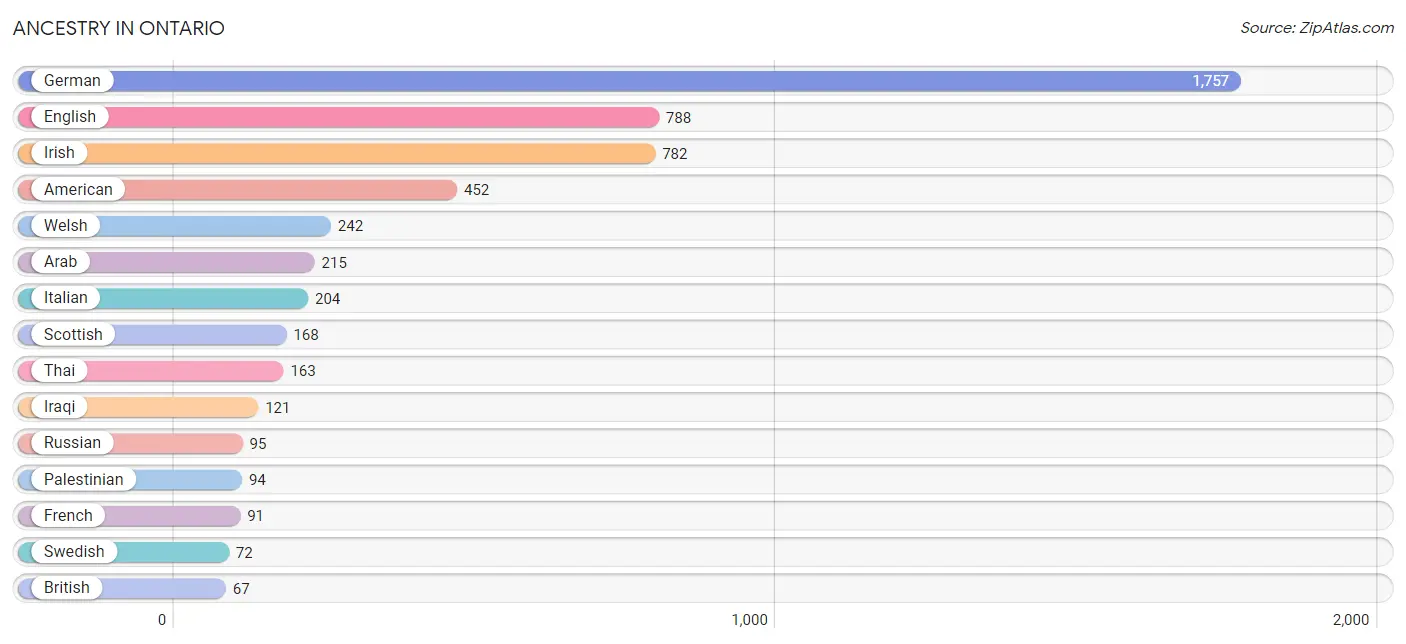
| Ancestry | # Population | % Population |
| American | 452 | 6.8% |
| Arab | 215 | 3.2% |
| Austrian | 48 | 0.7% |
| British | 67 | 1.0% |
| Cherokee | 10 | 0.2% |
| Dutch | 14 | 0.2% |
| Eastern European | 17 | 0.3% |
| English | 788 | 11.9% |
| European | 65 | 1.0% |
| Finnish | 16 | 0.2% |
| French | 91 | 1.4% |
| French Canadian | 33 | 0.5% |
| German | 1,757 | 26.5% |
| Hungarian | 33 | 0.5% |
| Iraqi | 121 | 1.8% |
| Irish | 782 | 11.8% |
| Italian | 204 | 3.1% |
| Macedonian | 21 | 0.3% |
| Mexican | 53 | 0.8% |
| Mexican American Indian | 10 | 0.2% |
| Norwegian | 28 | 0.4% |
| Palestinian | 94 | 1.4% |
| Polish | 15 | 0.2% |
| Puerto Rican | 38 | 0.6% |
| Russian | 95 | 1.4% |
| Scotch-Irish | 27 | 0.4% |
| Scottish | 168 | 2.5% |
| Slavic | 14 | 0.2% |
| Swedish | 72 | 1.1% |
| Swiss | 18 | 0.3% |
| Thai | 163 | 2.5% |
| Welsh | 242 | 3.6% |
| Yugoslavian | 53 | 0.8% | View All 33 Rows |
Immigrants in Ontario
The most numerous immigrant groups reported in Ontario came from Asia (295 | 4.4%), India (142 | 2.1%), South Central Asia (142 | 2.1%), Iraq (121 | 1.8%), and Western Asia (121 | 1.8%), together accounting for 12.4% of all Ontario residents.

| Immigration Origin | # Population | % Population |
| Asia | 295 | 4.4% |
| Bulgaria | 46 | 0.7% |
| Eastern Europe | 79 | 1.2% |
| Europe | 91 | 1.4% |
| Germany | 12 | 0.2% |
| India | 142 | 2.1% |
| Iraq | 121 | 1.8% |
| South Central Asia | 142 | 2.1% |
| Western Asia | 121 | 1.8% |
| Western Europe | 12 | 0.2% | View All 10 Rows |
Sex and Age in Ontario
Sex and Age in Ontario
The most populous age groups in Ontario are 50 to 54 Years (408 | 12.2%) for men and 60 to 64 Years (593 | 18.0%) for women.
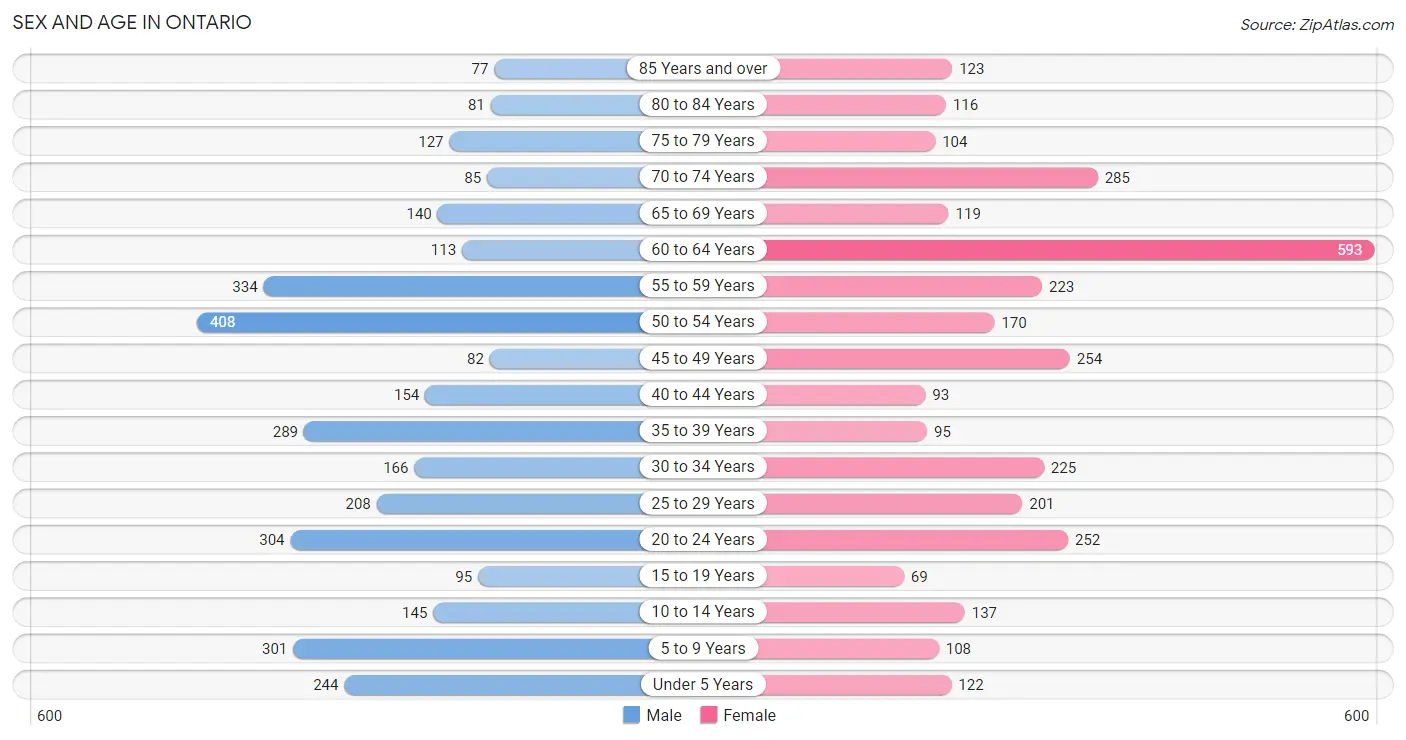
| Age Bracket | Male | Female |
| Under 5 Years | 244 (7.3%) | 122 (3.7%) |
| 5 to 9 Years | 301 (9.0%) | 108 (3.3%) |
| 10 to 14 Years | 145 (4.3%) | 137 (4.2%) |
| 15 to 19 Years | 95 (2.8%) | 69 (2.1%) |
| 20 to 24 Years | 304 (9.1%) | 252 (7.7%) |
| 25 to 29 Years | 208 (6.2%) | 201 (6.1%) |
| 30 to 34 Years | 166 (5.0%) | 225 (6.8%) |
| 35 to 39 Years | 289 (8.6%) | 95 (2.9%) |
| 40 to 44 Years | 154 (4.6%) | 93 (2.8%) |
| 45 to 49 Years | 82 (2.5%) | 254 (7.7%) |
| 50 to 54 Years | 408 (12.2%) | 170 (5.2%) |
| 55 to 59 Years | 334 (10.0%) | 223 (6.8%) |
| 60 to 64 Years | 113 (3.4%) | 593 (18.0%) |
| 65 to 69 Years | 140 (4.2%) | 119 (3.6%) |
| 70 to 74 Years | 85 (2.5%) | 285 (8.7%) |
| 75 to 79 Years | 127 (3.8%) | 104 (3.2%) |
| 80 to 84 Years | 81 (2.4%) | 116 (3.5%) |
| 85 Years and over | 77 (2.3%) | 123 (3.7%) |
| Total | 3,353 (100.0%) | 3,289 (100.0%) |
Families and Households in Ontario
Median Family Size in Ontario
The median family size in Ontario is 2.94 persons per family, with single male/father families (75 | 4.2%) accounting for the largest median family size of 3.17 persons per family. On the other hand, married-couple families (1,547 | 85.5%) represent the smallest median family size with 2.90 persons per family.

| Family Type | # Families | Family Size |
| Married-Couple | 1,547 (85.5%) | 2.90 |
| Single Male/Father | 75 (4.2%) | 3.17 |
| Single Female/Mother | 187 (10.3%) | 3.17 |
| Total Families | 1,809 (100.0%) | 2.94 |
Median Household Size in Ontario
The median household size in Ontario is 2.35 persons per household, with single female/mother households (187 | 6.7%) accounting for the largest median household size of 3.56 persons per household. non-family households (972 | 34.9%) represent the smallest median household size with 1.18 persons per household.

| Household Type | # Households | Household Size |
| Married-Couple | 1,547 (55.6%) | 2.90 |
| Single Male/Father | 75 (2.7%) | 3.17 |
| Single Female/Mother | 187 (6.7%) | 3.56 |
| Non-family | 972 (34.9%) | 1.18 |
| Total Households | 2,781 (100.0%) | 2.35 |
Household Size by Marriage Status in Ontario
Out of a total of 2,781 households in Ontario, 1,809 (65.0%) are family households, while 972 (34.9%) are nonfamily households. The most numerous type of family households are 2-person households, comprising 953, and the most common type of nonfamily households are 1-person households, comprising 796.

| Household Size | Family Households | Nonfamily Households |
| 1-Person Households | - | 796 (28.6%) |
| 2-Person Households | 953 (34.3%) | 176 (6.3%) |
| 3-Person Households | 405 (14.6%) | 0 (0.0%) |
| 4-Person Households | 351 (12.6%) | 0 (0.0%) |
| 5-Person Households | 84 (3.0%) | 0 (0.0%) |
| 6-Person Households | 16 (0.6%) | 0 (0.0%) |
| 7+ Person Households | 0 (0.0%) | 0 (0.0%) |
| Total | 1,809 (65.0%) | 972 (34.9%) |
Female Fertility in Ontario
Fertility by Age in Ontario

| Age Bracket | Women with Births | Births / 1,000 Women |
| 15 to 19 years | 0 (0.0%) | 0.0 |
| 20 to 34 years | 0 (0.0%) | 0.0 |
| 35 to 50 years | 0 (0.0%) | 0.0 |
| Total | 0 (0.0%) | 0.0 |
Fertility by Age by Marriage Status in Ontario

| Age Bracket | Married | Unmarried |
| 15 to 19 years | 0 (0.0%) | 0 (0.0%) |
| 20 to 34 years | 0 (0.0%) | 0 (0.0%) |
| 35 to 50 years | 0 (0.0%) | 0 (0.0%) |
| Total | 0 (0.0%) | 0 (0.0%) |
Fertility by Education in Ontario
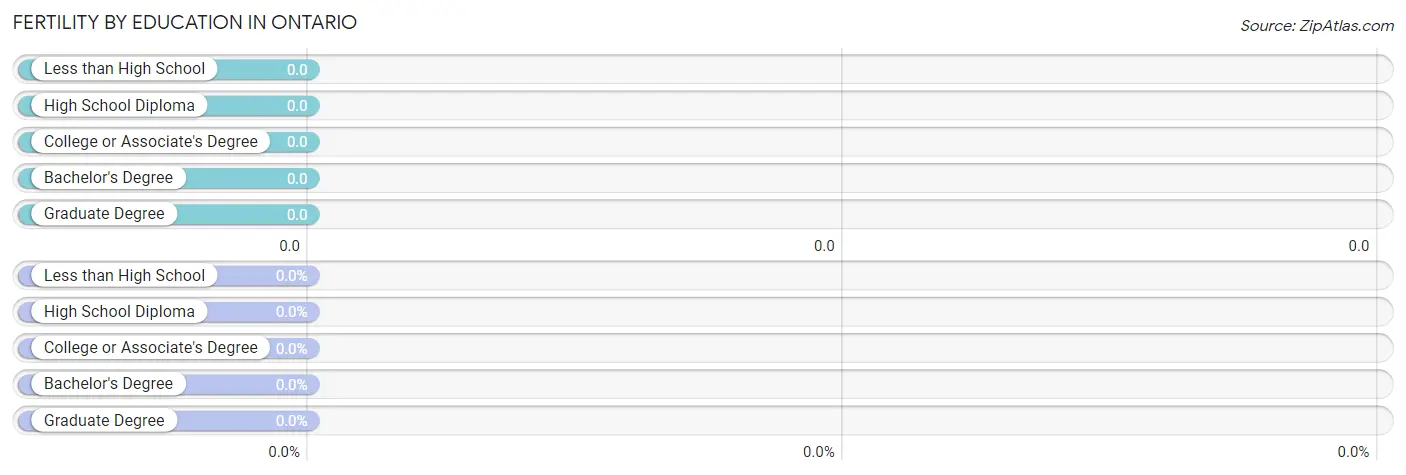
| Educational Attainment | Women with Births | Births / 1,000 Women |
| Less than High School | 0 (0.0%) | 0.0 |
| High School Diploma | 0 (0.0%) | 0.0 |
| College or Associate's Degree | 0 (0.0%) | 0.0 |
| Bachelor's Degree | 0 (0.0%) | 0.0 |
| Graduate Degree | 0 (0.0%) | 0.0 |
| Total | 0 (0.0%) | 0.0 |
Fertility by Education by Marriage Status in Ontario

| Educational Attainment | Married | Unmarried |
| Less than High School | 0 (0.0%) | 0 (0.0%) |
| High School Diploma | 0 (0.0%) | 0 (0.0%) |
| College or Associate's Degree | 0 (0.0%) | 0 (0.0%) |
| Bachelor's Degree | 0 (0.0%) | 0 (0.0%) |
| Graduate Degree | 0 (0.0%) | 0 (0.0%) |
| Total | 0 (0.0%) | 0 (0.0%) |
Employment Characteristics in Ontario
Employment by Class of Employer in Ontario
Among the 3,586 employed individuals in Ontario, private company employees (2,712 | 75.6%), local government employees (278 | 7.7%), and not-for-profit organizations (240 | 6.7%) make up the most common classes of employment.

| Employer Class | # Employees | % Employees |
| Private Company Employees | 2,712 | 75.6% |
| Self-Employed (Incorporated) | 122 | 3.4% |
| Self-Employed (Not Incorporated) | 109 | 3.0% |
| Not-for-profit Organizations | 240 | 6.7% |
| Local Government Employees | 278 | 7.7% |
| State Government Employees | 38 | 1.1% |
| Federal Government Employees | 87 | 2.4% |
| Unpaid Family Workers | 0 | 0.0% |
| Total | 3,586 | 100.0% |
Employment Status by Age in Ontario
According to the labor force statistics for Ontario, out of the total population over 16 years of age (5,585), 68.7% or 3,837 individuals are in the labor force, with 4.9% or 188 of them unemployed. The age group with the highest labor force participation rate is 45 to 54 years, with 96.5% or 882 individuals in the labor force. Within the labor force, the 16 to 19 years age range has the highest percentage of unemployed individuals, with 24.6% or 17 of them being unemployed.

| Age Bracket | In Labor Force | Unemployed |
| 16 to 19 Years | 69 (42.1%) | 17 (24.6%) |
| 20 to 24 Years | 503 (90.5%) | 61 (12.1%) |
| 25 to 29 Years | 389 (95.1%) | 0 (0.0%) |
| 30 to 34 Years | 316 (80.8%) | 38 (12.0%) |
| 35 to 44 Years | 563 (89.2%) | 5 (0.9%) |
| 45 to 54 Years | 882 (96.5%) | 0 (0.0%) |
| 55 to 59 Years | 453 (81.3%) | 47 (10.4%) |
| 60 to 64 Years | 490 (69.4%) | 18 (3.7%) |
| 65 to 74 Years | 128 (20.3%) | 0 (0.0%) |
| 75 Years and over | 46 (7.3%) | 0 (0.0%) |
| Total | 3,837 (68.7%) | 188 (4.9%) |
Employment Status by Educational Attainment in Ontario
According to labor force statistics for Ontario, 85.7% of individuals (3,092) out of the total population between 25 and 64 years of age (3,608) are in the labor force, with 3.5% or 108 of them being unemployed. The group with the highest labor force participation rate are those with the educational attainment of high school diploma, with 92.3% or 946 individuals in the labor force. Within the labor force, individuals with high school diploma education have the highest percentage of unemployment, with 6.4% or 61 of them being unemployed.

| Educational Attainment | In Labor Force | Unemployed |
| Less than High School | 101 (74.3%) | 0 (0.0%) |
| High School Diploma | 946 (92.3%) | 66 (6.4%) |
| College / Associate Degree | 1,201 (80.0%) | 0 (0.0%) |
| Bachelor's Degree or higher | 845 (89.3%) | 55 (5.8%) |
| Total | 3,092 (85.7%) | 126 (3.5%) |
Employment Occupations by Sex in Ontario
Management, Business, Science and Arts Occupations
The most common Management, Business, Science and Arts occupations in Ontario are Management (466 | 12.9%), Community & Social Service (460 | 12.7%), Education Instruction & Library (228 | 6.3%), Health Diagnosing & Treating (177 | 4.9%), and Arts, Media & Entertainment (126 | 3.5%).
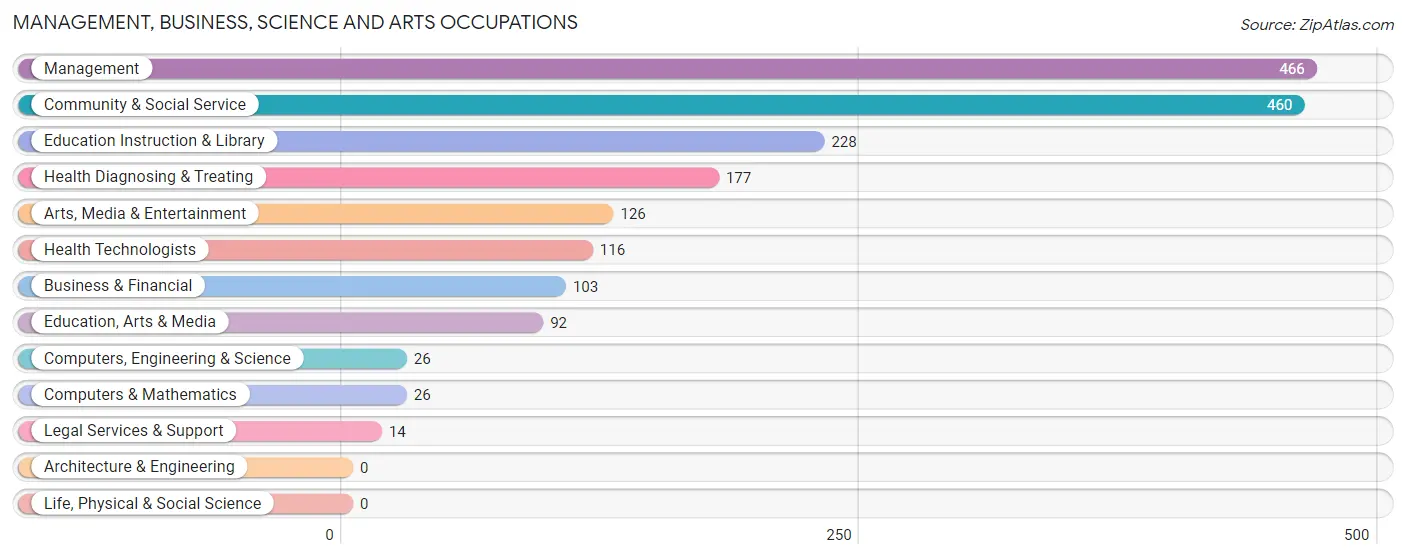
Management, Business, Science and Arts Occupations by Sex
Within the Management, Business, Science and Arts occupations in Ontario, the most male-oriented occupations are Computers, Engineering & Science (100.0%), Computers & Mathematics (100.0%), and Management (74.9%), while the most female-oriented occupations are Business & Financial (100.0%), Legal Services & Support (100.0%), and Health Diagnosing & Treating (88.7%).
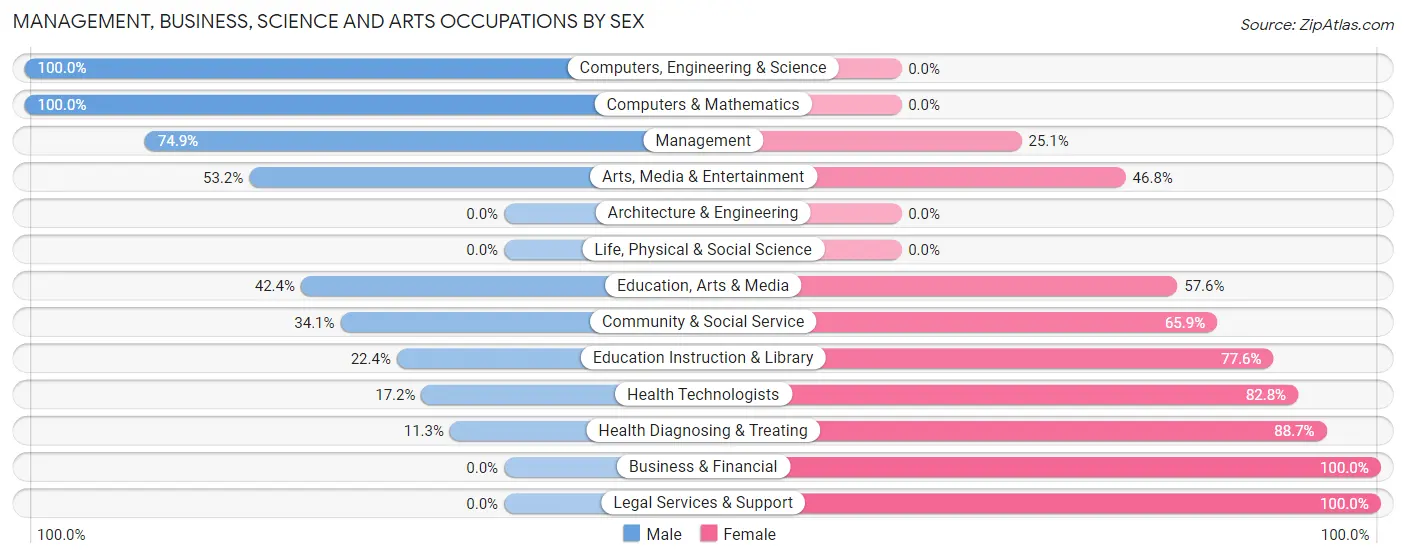
| Occupation | Male | Female |
| Management | 349 (74.9%) | 117 (25.1%) |
| Business & Financial | 0 (0.0%) | 103 (100.0%) |
| Computers, Engineering & Science | 26 (100.0%) | 0 (0.0%) |
| Computers & Mathematics | 26 (100.0%) | 0 (0.0%) |
| Architecture & Engineering | 0 (0.0%) | 0 (0.0%) |
| Life, Physical & Social Science | 0 (0.0%) | 0 (0.0%) |
| Community & Social Service | 157 (34.1%) | 303 (65.9%) |
| Education, Arts & Media | 39 (42.4%) | 53 (57.6%) |
| Legal Services & Support | 0 (0.0%) | 14 (100.0%) |
| Education Instruction & Library | 51 (22.4%) | 177 (77.6%) |
| Arts, Media & Entertainment | 67 (53.2%) | 59 (46.8%) |
| Health Diagnosing & Treating | 20 (11.3%) | 157 (88.7%) |
| Health Technologists | 20 (17.2%) | 96 (82.8%) |
| Total (Category) | 552 (44.8%) | 680 (55.2%) |
| Total (Overall) | 1,944 (53.6%) | 1,680 (46.4%) |
Services Occupations
The most common Services occupations in Ontario are Food Preparation & Serving (236 | 6.5%), Healthcare Support (150 | 4.1%), Security & Protection (119 | 3.3%), Firefighting & Prevention (93 | 2.6%), and Cleaning & Maintenance (63 | 1.7%).

Services Occupations by Sex
Within the Services occupations in Ontario, the most male-oriented occupations are Law Enforcement (100.0%), Security & Protection (81.5%), and Firefighting & Prevention (76.3%), while the most female-oriented occupations are Healthcare Support (100.0%), Cleaning & Maintenance (80.9%), and Food Preparation & Serving (74.2%).

| Occupation | Male | Female |
| Healthcare Support | 0 (0.0%) | 150 (100.0%) |
| Security & Protection | 97 (81.5%) | 22 (18.5%) |
| Firefighting & Prevention | 71 (76.3%) | 22 (23.7%) |
| Law Enforcement | 26 (100.0%) | 0 (0.0%) |
| Food Preparation & Serving | 61 (25.9%) | 175 (74.2%) |
| Cleaning & Maintenance | 12 (19.1%) | 51 (80.9%) |
| Personal Care & Service | 0 (0.0%) | 0 (0.0%) |
| Total (Category) | 170 (29.9%) | 398 (70.1%) |
| Total (Overall) | 1,944 (53.6%) | 1,680 (46.4%) |
Sales and Office Occupations
The most common Sales and Office occupations in Ontario are Office & Administration (564 | 15.6%), and Sales & Related (343 | 9.5%).

Sales and Office Occupations by Sex

| Occupation | Male | Female |
| Sales & Related | 233 (67.9%) | 110 (32.1%) |
| Office & Administration | 243 (43.1%) | 321 (56.9%) |
| Total (Category) | 476 (52.5%) | 431 (47.5%) |
| Total (Overall) | 1,944 (53.6%) | 1,680 (46.4%) |
Natural Resources, Construction and Maintenance Occupations
The most common Natural Resources, Construction and Maintenance occupations in Ontario are Construction & Extraction (206 | 5.7%), Installation, Maintenance & Repair (107 | 2.9%), and Farming, Fishing & Forestry (17 | 0.5%).

Natural Resources, Construction and Maintenance Occupations by Sex

| Occupation | Male | Female |
| Farming, Fishing & Forestry | 0 (0.0%) | 17 (100.0%) |
| Construction & Extraction | 206 (100.0%) | 0 (0.0%) |
| Installation, Maintenance & Repair | 96 (89.7%) | 11 (10.3%) |
| Total (Category) | 302 (91.5%) | 28 (8.5%) |
| Total (Overall) | 1,944 (53.6%) | 1,680 (46.4%) |
Production, Transportation and Moving Occupations
The most common Production, Transportation and Moving occupations in Ontario are Production (247 | 6.8%), Material Moving (176 | 4.9%), and Transportation (164 | 4.5%).

Production, Transportation and Moving Occupations by Sex

| Occupation | Male | Female |
| Production | 142 (57.5%) | 105 (42.5%) |
| Transportation | 126 (76.8%) | 38 (23.2%) |
| Material Moving | 176 (100.0%) | 0 (0.0%) |
| Total (Category) | 444 (75.6%) | 143 (24.4%) |
| Total (Overall) | 1,944 (53.6%) | 1,680 (46.4%) |
Employment Industries by Sex in Ontario
Employment Industries in Ontario
The major employment industries in Ontario include Retail Trade (585 | 16.1%), Health Care & Social Assistance (568 | 15.7%), Manufacturing (527 | 14.5%), Educational Services (357 | 9.9%), and Construction (298 | 8.2%).
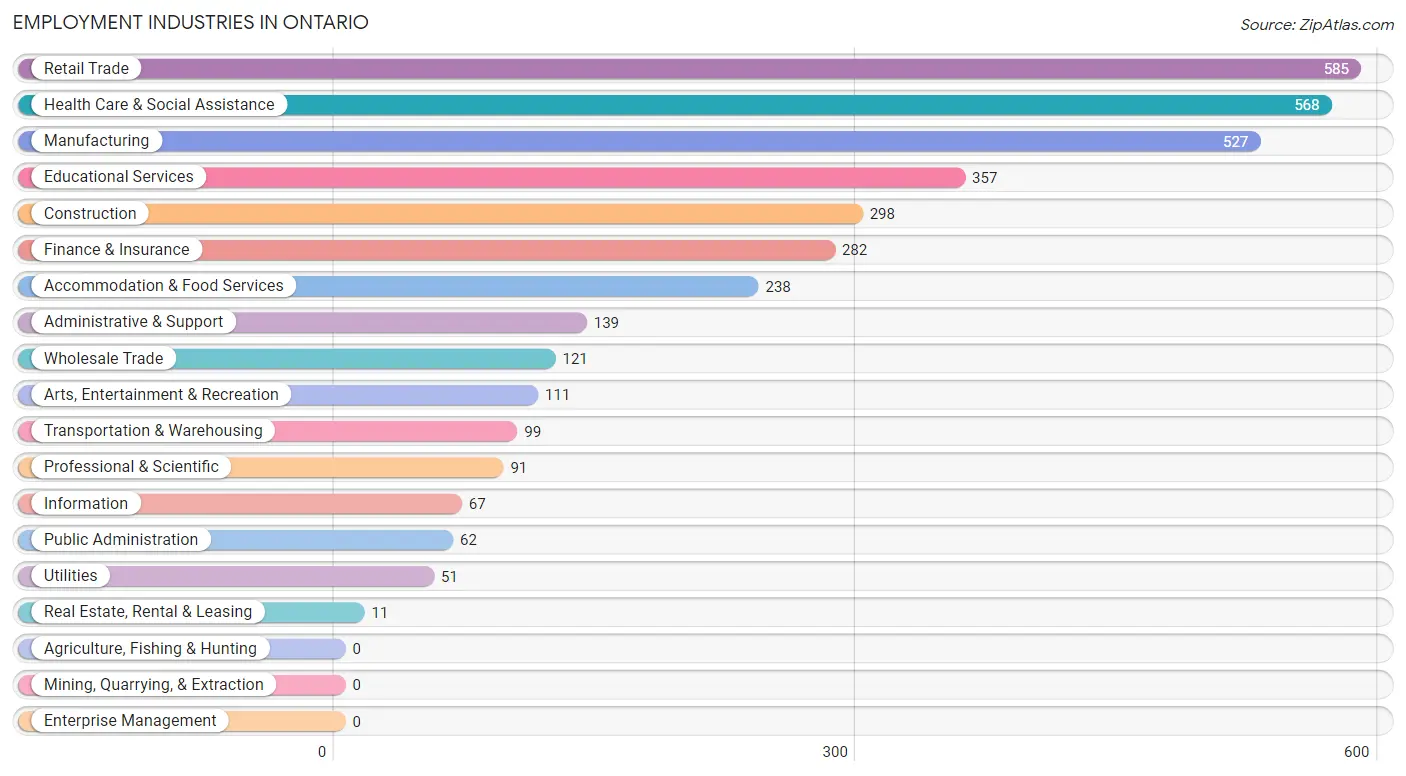
Employment Industries by Sex in Ontario
The Ontario industries that see more men than women are Wholesale Trade (100.0%), Utilities (100.0%), and Information (100.0%), whereas the industries that tend to have a higher number of women are Professional & Scientific (100.0%), Health Care & Social Assistance (85.9%), and Educational Services (77.3%).
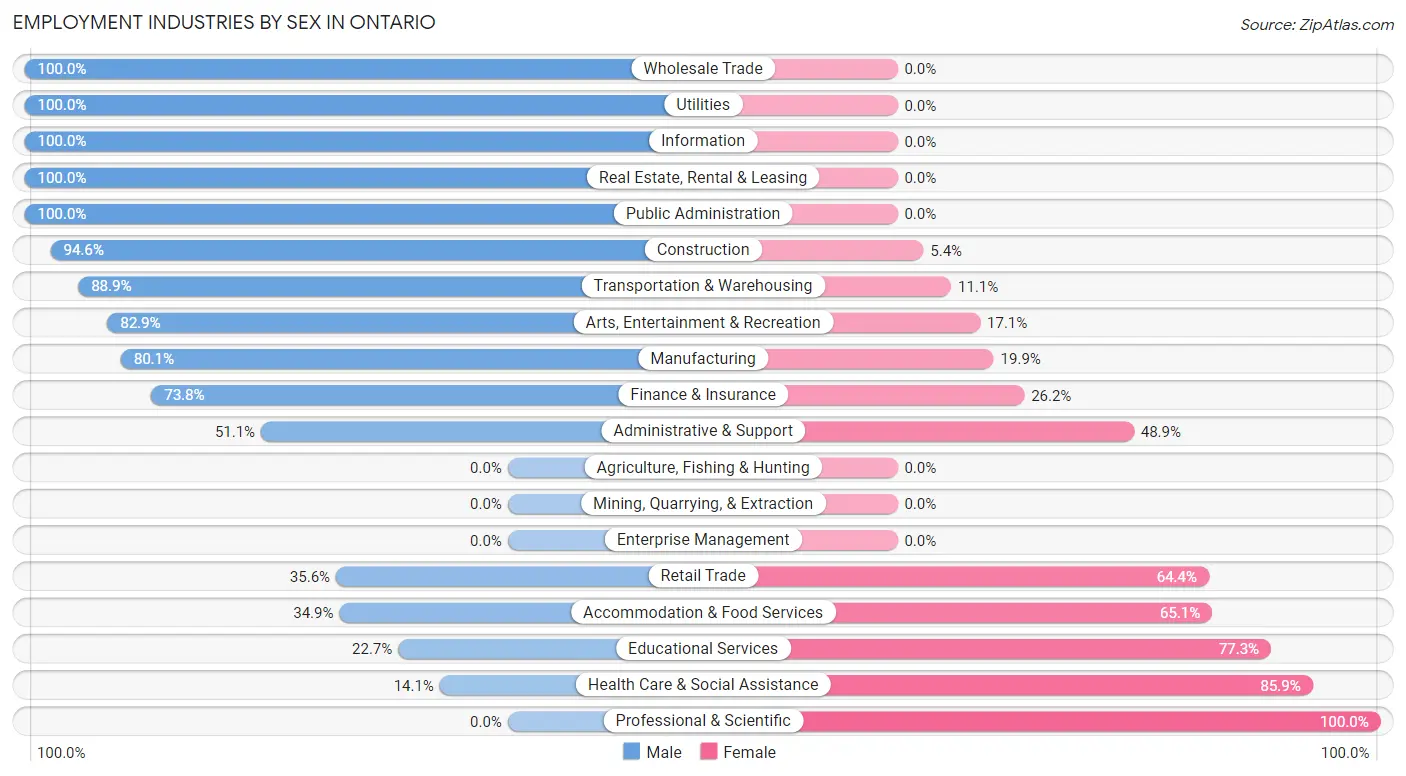
| Industry | Male | Female |
| Agriculture, Fishing & Hunting | 0 (0.0%) | 0 (0.0%) |
| Mining, Quarrying, & Extraction | 0 (0.0%) | 0 (0.0%) |
| Construction | 282 (94.6%) | 16 (5.4%) |
| Manufacturing | 422 (80.1%) | 105 (19.9%) |
| Wholesale Trade | 121 (100.0%) | 0 (0.0%) |
| Retail Trade | 208 (35.6%) | 377 (64.4%) |
| Transportation & Warehousing | 88 (88.9%) | 11 (11.1%) |
| Utilities | 51 (100.0%) | 0 (0.0%) |
| Information | 67 (100.0%) | 0 (0.0%) |
| Finance & Insurance | 208 (73.8%) | 74 (26.2%) |
| Real Estate, Rental & Leasing | 11 (100.0%) | 0 (0.0%) |
| Professional & Scientific | 0 (0.0%) | 91 (100.0%) |
| Enterprise Management | 0 (0.0%) | 0 (0.0%) |
| Administrative & Support | 71 (51.1%) | 68 (48.9%) |
| Educational Services | 81 (22.7%) | 276 (77.3%) |
| Health Care & Social Assistance | 80 (14.1%) | 488 (85.9%) |
| Arts, Entertainment & Recreation | 92 (82.9%) | 19 (17.1%) |
| Accommodation & Food Services | 83 (34.9%) | 155 (65.1%) |
| Public Administration | 62 (100.0%) | 0 (0.0%) |
| Total | 1,944 (53.6%) | 1,680 (46.4%) |
Education in Ontario
School Enrollment in Ontario
The most common levels of schooling among the 1,385 students in Ontario are elementary school (344 | 24.8%), college / undergraduate (249 | 18.0%), and middle school (238 | 17.2%).

| School Level | # Students | % Students |
| Nursery / Preschool | 154 | 11.1% |
| Kindergarten | 64 | 4.6% |
| Elementary School | 344 | 24.8% |
| Middle School | 238 | 17.2% |
| High School | 213 | 15.4% |
| College / Undergraduate | 249 | 18.0% |
| Graduate / Professional | 123 | 8.9% |
| Total | 1,385 | 100.0% |
School Enrollment by Age by Funding Source in Ontario
Out of a total of 1,385 students who are enrolled in schools in Ontario, 143 (10.3%) attend a private institution, while the remaining 1,242 (89.7%) are enrolled in public schools. The age group of 25 to 34 year olds has the highest likelihood of being enrolled in private schools, with 17 (24.3% in the age bracket) enrolled. Conversely, the age group of 15 to 17 year olds has the lowest likelihood of being enrolled in a private school, with 115 (100.0% in the age bracket) attending a public institution.

| Age Bracket | Public School | Private School |
| 3 to 4 Year Olds | 139 (90.3%) | 15 (9.7%) |
| 5 to 9 Year Old | 382 (95.0%) | 20 (5.0%) |
| 10 to 14 Year Olds | 221 (78.4%) | 61 (21.6%) |
| 15 to 17 Year Olds | 115 (100.0%) | 0 (0.0%) |
| 18 to 19 Year Olds | 49 (100.0%) | 0 (0.0%) |
| 20 to 24 Year Olds | 180 (100.0%) | 0 (0.0%) |
| 25 to 34 Year Olds | 53 (75.7%) | 17 (24.3%) |
| 35 Years and over | 104 (78.2%) | 29 (21.8%) |
| Total | 1,242 (89.7%) | 143 (10.3%) |
Educational Attainment by Field of Study in Ontario
Education (372 | 27.9%), business (307 | 23.1%), science & technology (184 | 13.8%), liberal arts & history (124 | 9.3%), and psychology (66 | 5.0%) are the most common fields of study among 1,332 individuals in Ontario who have obtained a bachelor's degree or higher.
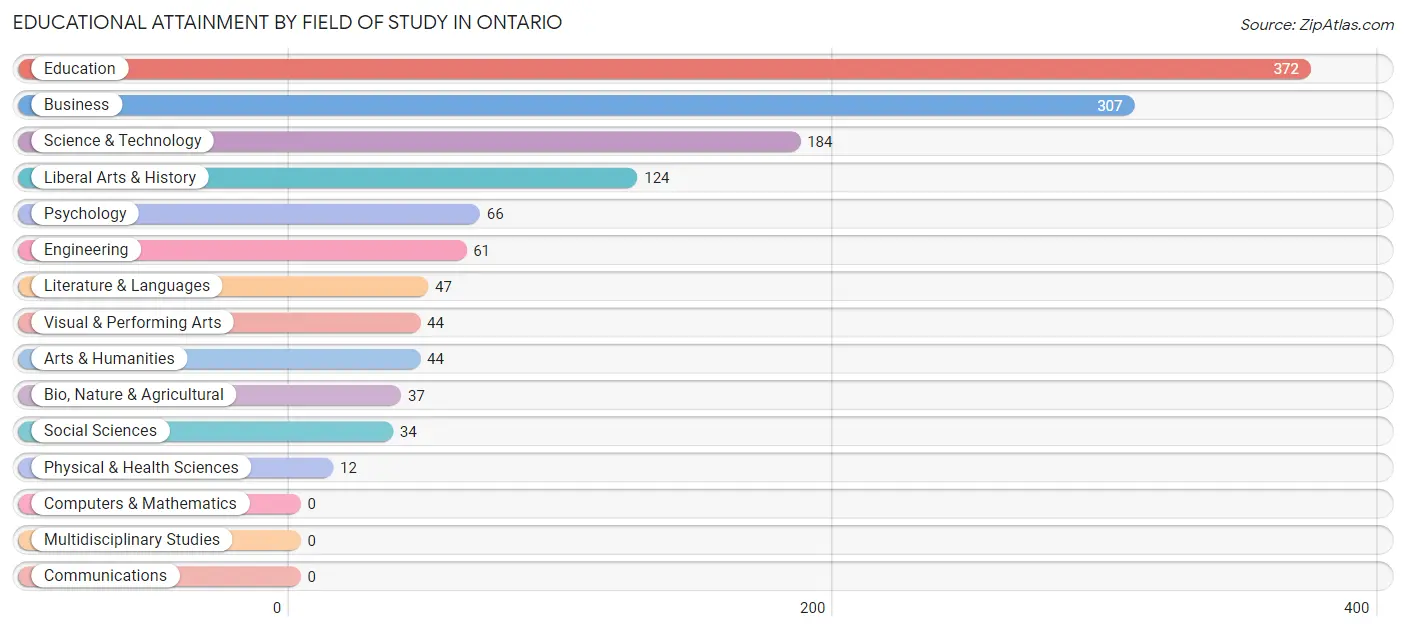
| Field of Study | # Graduates | % Graduates |
| Computers & Mathematics | 0 | 0.0% |
| Bio, Nature & Agricultural | 37 | 2.8% |
| Physical & Health Sciences | 12 | 0.9% |
| Psychology | 66 | 5.0% |
| Social Sciences | 34 | 2.5% |
| Engineering | 61 | 4.6% |
| Multidisciplinary Studies | 0 | 0.0% |
| Science & Technology | 184 | 13.8% |
| Business | 307 | 23.1% |
| Education | 372 | 27.9% |
| Literature & Languages | 47 | 3.5% |
| Liberal Arts & History | 124 | 9.3% |
| Visual & Performing Arts | 44 | 3.3% |
| Communications | 0 | 0.0% |
| Arts & Humanities | 44 | 3.3% |
| Total | 1,332 | 100.0% |
Transportation & Commute in Ontario
Vehicle Availability by Sex in Ontario
The most prevalent vehicle ownership categories in Ontario are males with 2 vehicles (1,096, accounting for 57.2%) and females with 2 vehicles (833, making up 68.4%).

| Vehicles Available | Male | Female |
| No Vehicle | 0 (0.0%) | 87 (5.4%) |
| 1 Vehicle | 339 (17.7%) | 286 (17.8%) |
| 2 Vehicles | 1,096 (57.2%) | 833 (52.0%) |
| 3 Vehicles | 358 (18.7%) | 317 (19.8%) |
| 4 Vehicles | 122 (6.4%) | 80 (5.0%) |
| 5 or more Vehicles | 0 (0.0%) | 0 (0.0%) |
| Total | 1,915 (100.0%) | 1,603 (100.0%) |
Commute Time in Ontario
The most frequently occuring commute durations in Ontario are 5 to 9 minutes (830 commuters, 23.9%), 15 to 19 minutes (765 commuters, 22.1%), and 10 to 14 minutes (496 commuters, 14.3%).
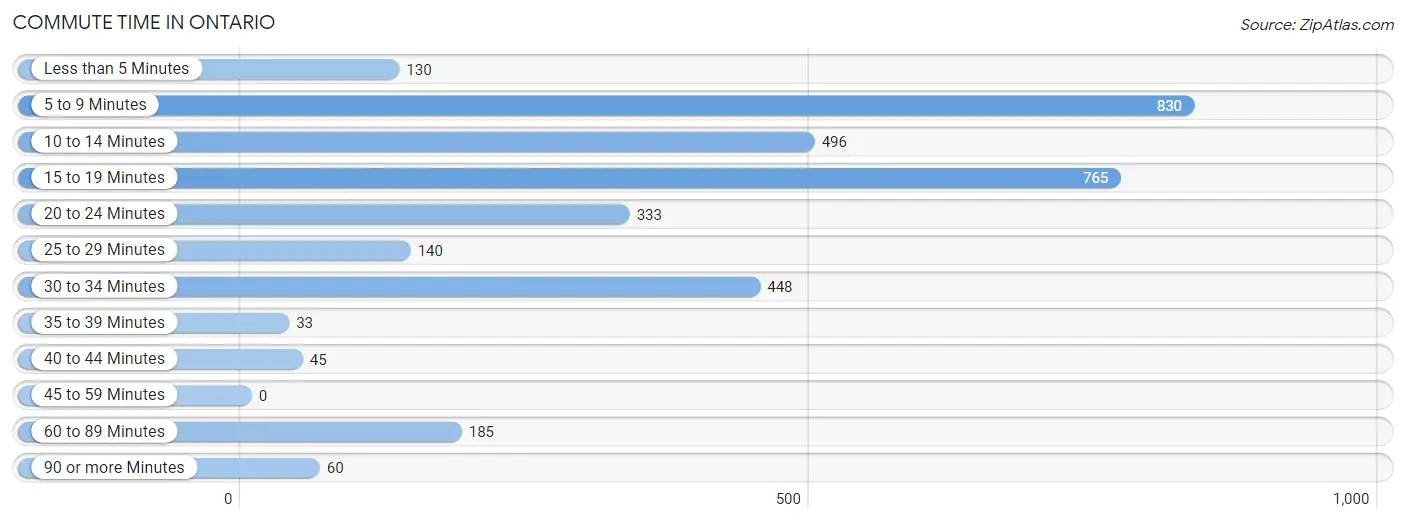
| Commute Time | # Commuters | % Commuters |
| Less than 5 Minutes | 130 | 3.7% |
| 5 to 9 Minutes | 830 | 23.9% |
| 10 to 14 Minutes | 496 | 14.3% |
| 15 to 19 Minutes | 765 | 22.1% |
| 20 to 24 Minutes | 333 | 9.6% |
| 25 to 29 Minutes | 140 | 4.0% |
| 30 to 34 Minutes | 448 | 12.9% |
| 35 to 39 Minutes | 33 | 0.9% |
| 40 to 44 Minutes | 45 | 1.3% |
| 45 to 59 Minutes | 0 | 0.0% |
| 60 to 89 Minutes | 185 | 5.3% |
| 90 or more Minutes | 60 | 1.7% |
Commute Time by Sex in Ontario
The most common commute times in Ontario are 5 to 9 minutes (436 commuters, 23.5%) for males and 15 to 19 minutes (429 commuters, 26.7%) for females.
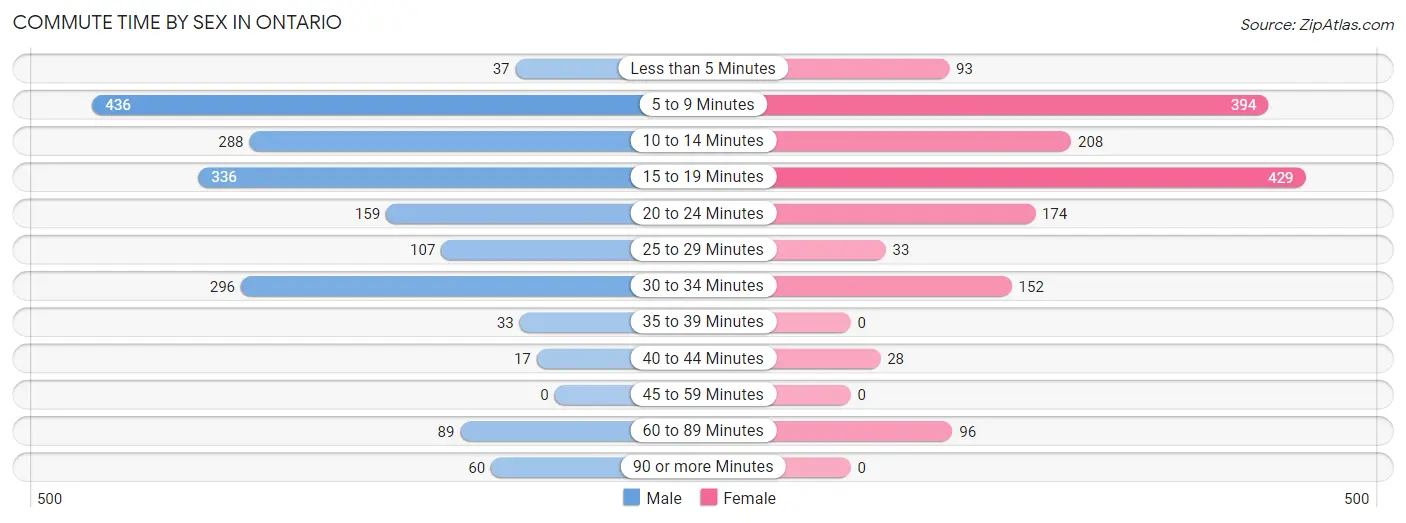
| Commute Time | Male | Female |
| Less than 5 Minutes | 37 (2.0%) | 93 (5.8%) |
| 5 to 9 Minutes | 436 (23.5%) | 394 (24.5%) |
| 10 to 14 Minutes | 288 (15.5%) | 208 (12.9%) |
| 15 to 19 Minutes | 336 (18.1%) | 429 (26.7%) |
| 20 to 24 Minutes | 159 (8.6%) | 174 (10.8%) |
| 25 to 29 Minutes | 107 (5.8%) | 33 (2.1%) |
| 30 to 34 Minutes | 296 (15.9%) | 152 (9.5%) |
| 35 to 39 Minutes | 33 (1.8%) | 0 (0.0%) |
| 40 to 44 Minutes | 17 (0.9%) | 28 (1.7%) |
| 45 to 59 Minutes | 0 (0.0%) | 0 (0.0%) |
| 60 to 89 Minutes | 89 (4.8%) | 96 (6.0%) |
| 90 or more Minutes | 60 (3.2%) | 0 (0.0%) |
Time of Departure to Work by Sex in Ontario
The most frequent times of departure to work in Ontario are 7:00 AM to 7:29 AM (283, 15.2%) for males and 7:30 AM to 7:59 AM (238, 14.8%) for females.
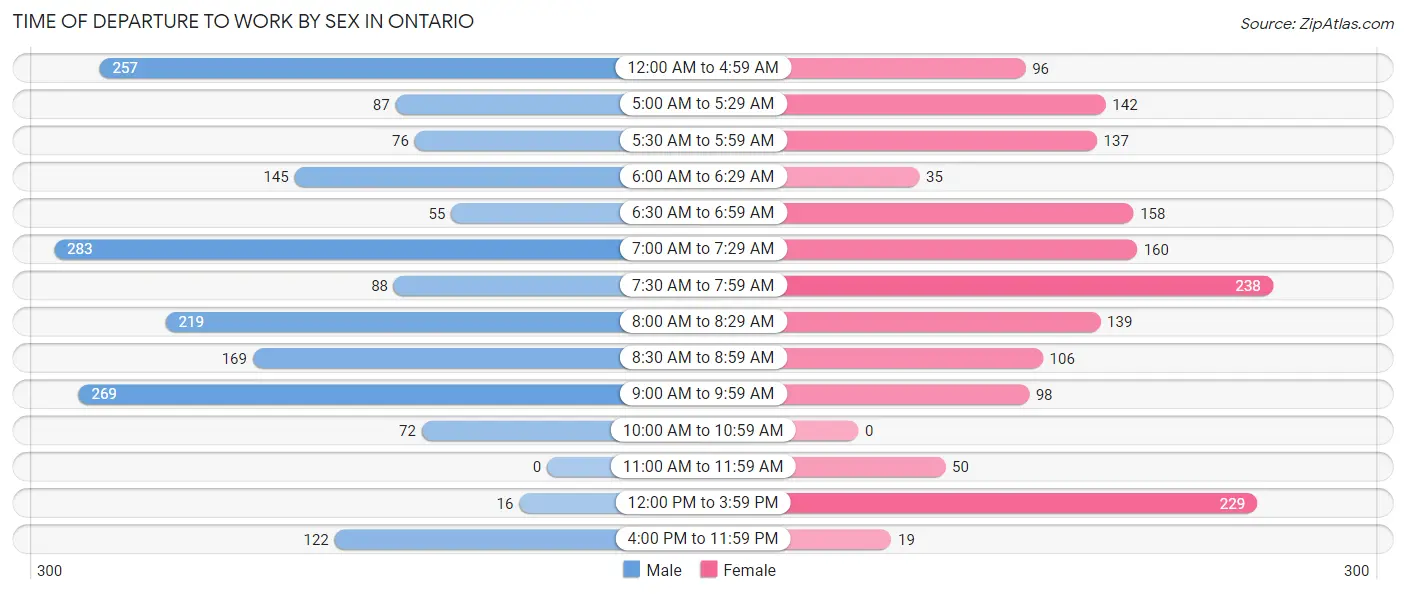
| Time of Departure | Male | Female |
| 12:00 AM to 4:59 AM | 257 (13.8%) | 96 (6.0%) |
| 5:00 AM to 5:29 AM | 87 (4.7%) | 142 (8.8%) |
| 5:30 AM to 5:59 AM | 76 (4.1%) | 137 (8.5%) |
| 6:00 AM to 6:29 AM | 145 (7.8%) | 35 (2.2%) |
| 6:30 AM to 6:59 AM | 55 (3.0%) | 158 (9.8%) |
| 7:00 AM to 7:29 AM | 283 (15.2%) | 160 (10.0%) |
| 7:30 AM to 7:59 AM | 88 (4.7%) | 238 (14.8%) |
| 8:00 AM to 8:29 AM | 219 (11.8%) | 139 (8.6%) |
| 8:30 AM to 8:59 AM | 169 (9.1%) | 106 (6.6%) |
| 9:00 AM to 9:59 AM | 269 (14.5%) | 98 (6.1%) |
| 10:00 AM to 10:59 AM | 72 (3.9%) | 0 (0.0%) |
| 11:00 AM to 11:59 AM | 0 (0.0%) | 50 (3.1%) |
| 12:00 PM to 3:59 PM | 16 (0.9%) | 229 (14.2%) |
| 4:00 PM to 11:59 PM | 122 (6.6%) | 19 (1.2%) |
| Total | 1,858 (100.0%) | 1,607 (100.0%) |
Housing Occupancy in Ontario
Occupancy by Ownership in Ontario
Of the total 2,781 dwellings in Ontario, owner-occupied units account for 1,812 (65.2%), while renter-occupied units make up 969 (34.8%).

| Occupancy | # Housing Units | % Housing Units |
| Owner Occupied Housing Units | 1,812 | 65.2% |
| Renter-Occupied Housing Units | 969 | 34.8% |
| Total Occupied Housing Units | 2,781 | 100.0% |
Occupancy by Household Size in Ontario

| Household Size | # Housing Units | % Housing Units |
| 1-Person Household | 796 | 28.6% |
| 2-Person Household | 1,129 | 40.6% |
| 3-Person Household | 405 | 14.6% |
| 4+ Person Household | 451 | 16.2% |
| Total Housing Units | 2,781 | 100.0% |
Occupancy by Ownership by Household Size in Ontario

| Household Size | Owner-occupied | Renter-occupied |
| 1-Person Household | 365 (45.9%) | 431 (54.1%) |
| 2-Person Household | 841 (74.5%) | 288 (25.5%) |
| 3-Person Household | 338 (83.5%) | 67 (16.5%) |
| 4+ Person Household | 268 (59.4%) | 183 (40.6%) |
| Total Housing Units | 1,812 (65.2%) | 969 (34.8%) |
Occupancy by Educational Attainment in Ontario

| Household Size | Owner-occupied | Renter-occupied |
| Less than High School | 134 (64.1%) | 75 (35.9%) |
| High School Diploma | 549 (60.0%) | 366 (40.0%) |
| College/Associate Degree | 485 (58.9%) | 339 (41.1%) |
| Bachelor's Degree or higher | 644 (77.3%) | 189 (22.7%) |
Occupancy by Age of Householder in Ontario

| Age Bracket | # Households | % Households |
| Under 35 Years | 461 | 16.6% |
| 35 to 44 Years | 313 | 11.3% |
| 45 to 54 Years | 410 | 14.7% |
| 55 to 64 Years | 750 | 27.0% |
| 65 to 74 Years | 450 | 16.2% |
| 75 to 84 Years | 231 | 8.3% |
| 85 Years and Over | 166 | 6.0% |
| Total | 2,781 | 100.0% |
Housing Finances in Ontario
Median Income by Occupancy in Ontario

| Occupancy Type | # Households | Median Income |
| Owner-Occupied | 1,812 (65.2%) | $71,806 |
| Renter-Occupied | 969 (34.8%) | $46,181 |
| Average | 2,781 (100.0%) | $62,313 |
Occupancy by Householder Income Bracket in Ontario
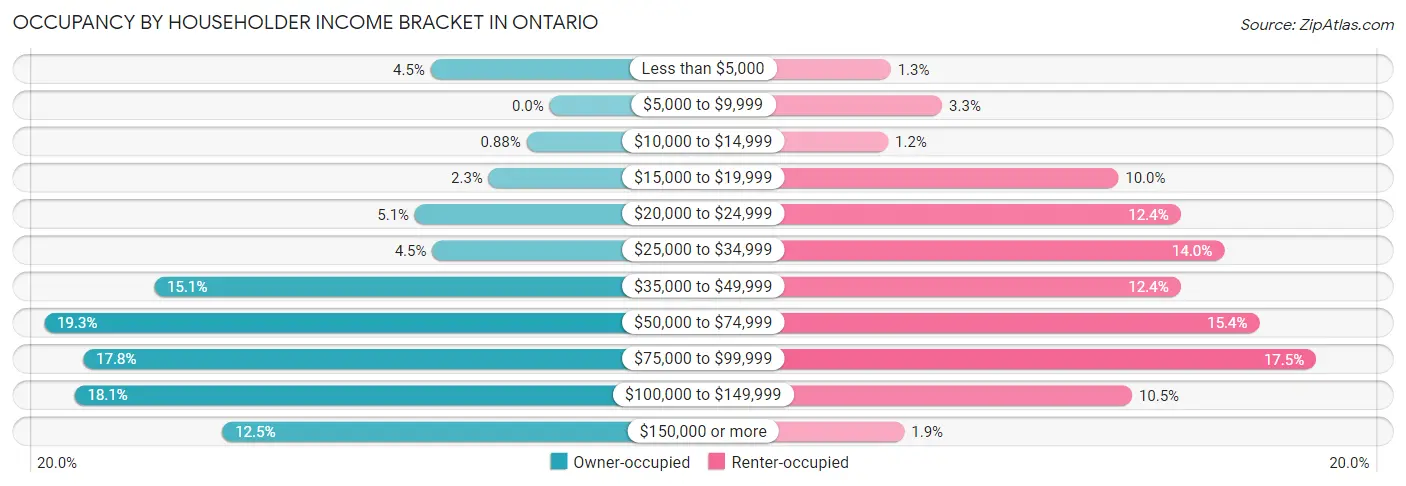
| Income Bracket | Owner-occupied | Renter-occupied |
| Less than $5,000 | 82 (4.5%) | 13 (1.3%) |
| $5,000 to $9,999 | 0 (0.0%) | 32 (3.3%) |
| $10,000 to $14,999 | 16 (0.9%) | 12 (1.2%) |
| $15,000 to $19,999 | 42 (2.3%) | 97 (10.0%) |
| $20,000 to $24,999 | 93 (5.1%) | 120 (12.4%) |
| $25,000 to $34,999 | 81 (4.5%) | 136 (14.0%) |
| $35,000 to $49,999 | 273 (15.1%) | 120 (12.4%) |
| $50,000 to $74,999 | 349 (19.3%) | 149 (15.4%) |
| $75,000 to $99,999 | 322 (17.8%) | 170 (17.5%) |
| $100,000 to $149,999 | 328 (18.1%) | 102 (10.5%) |
| $150,000 or more | 226 (12.5%) | 18 (1.9%) |
| Total | 1,812 (100.0%) | 969 (100.0%) |
Monthly Housing Cost Tiers in Ontario

| Monthly Cost | Owner-occupied | Renter-occupied |
| Less than $300 | 58 (3.2%) | 0 (0.0%) |
| $300 to $499 | 359 (19.8%) | 0 (0.0%) |
| $500 to $799 | 320 (17.7%) | 211 (21.8%) |
| $800 to $999 | 280 (15.4%) | 240 (24.8%) |
| $1,000 to $1,499 | 509 (28.1%) | 392 (40.5%) |
| $1,500 to $1,999 | 185 (10.2%) | 67 (6.9%) |
| $2,000 to $2,499 | 51 (2.8%) | 0 (0.0%) |
| $2,500 to $2,999 | 0 (0.0%) | 0 (0.0%) |
| $3,000 or more | 50 (2.8%) | 16 (1.7%) |
| Total | 1,812 (100.0%) | 969 (100.0%) |
Physical Housing Characteristics in Ontario
Housing Structures in Ontario

| Structure Type | # Housing Units | % Housing Units |
| Single Unit, Detached | 1,761 | 63.3% |
| Single Unit, Attached | 433 | 15.6% |
| 2 Unit Apartments | 157 | 5.7% |
| 3 or 4 Unit Apartments | 113 | 4.1% |
| 5 to 9 Unit Apartments | 173 | 6.2% |
| 10 or more Apartments | 144 | 5.2% |
| Mobile Home / Other | 0 | 0.0% |
| Total | 2,781 | 100.0% |
Housing Structures by Occupancy in Ontario

| Structure Type | Owner-occupied | Renter-occupied |
| Single Unit, Detached | 1,459 (82.9%) | 302 (17.2%) |
| Single Unit, Attached | 295 (68.1%) | 138 (31.9%) |
| 2 Unit Apartments | 16 (10.2%) | 141 (89.8%) |
| 3 or 4 Unit Apartments | 26 (23.0%) | 87 (77.0%) |
| 5 to 9 Unit Apartments | 16 (9.2%) | 157 (90.7%) |
| 10 or more Apartments | 0 (0.0%) | 144 (100.0%) |
| Mobile Home / Other | 0 (0.0%) | 0 (0.0%) |
| Total | 1,812 (65.2%) | 969 (34.8%) |
Housing Structures by Number of Rooms in Ontario

| Number of Rooms | Owner-occupied | Renter-occupied |
| 1 Room | 0 (0.0%) | 0 (0.0%) |
| 2 or 3 Rooms | 224 (12.4%) | 200 (20.6%) |
| 4 or 5 Rooms | 439 (24.2%) | 344 (35.5%) |
| 6 or 7 Rooms | 600 (33.1%) | 299 (30.9%) |
| 8 or more Rooms | 549 (30.3%) | 126 (13.0%) |
| Total | 1,812 (100.0%) | 969 (100.0%) |
Housing Structure by Heating Type in Ontario

| Heating Type | Owner-occupied | Renter-occupied |
| Utility Gas | 1,399 (77.2%) | 500 (51.6%) |
| Bottled, Tank, or LP Gas | 10 (0.5%) | 28 (2.9%) |
| Electricity | 400 (22.1%) | 402 (41.5%) |
| Fuel Oil or Kerosene | 3 (0.2%) | 12 (1.2%) |
| Coal or Coke | 0 (0.0%) | 0 (0.0%) |
| All other Fuels | 0 (0.0%) | 27 (2.8%) |
| No Fuel Used | 0 (0.0%) | 0 (0.0%) |
| Total | 1,812 (100.0%) | 969 (100.0%) |
Household Vehicle Usage in Ontario

| Vehicles per Household | Owner-occupied | Renter-occupied |
| No Vehicle | 29 (1.6%) | 168 (17.3%) |
| 1 Vehicle | 662 (36.5%) | 297 (30.6%) |
| 2 Vehicles | 739 (40.8%) | 448 (46.2%) |
| 3 or more Vehicles | 382 (21.1%) | 56 (5.8%) |
| Total | 1,812 (100.0%) | 969 (100.0%) |
Real Estate & Mortgages in Ontario
Real Estate and Mortgage Overview in Ontario
| Characteristic | Without Mortgage | With Mortgage |
| Housing Units | 736 | 1,076 |
| Median Property Value | $150,600 | $143,300 |
| Median Household Income | $59,375 | $128 |
| Monthly Housing Costs | $481 | $50 |
| Real Estate Taxes | $2,341 | $27 |
Property Value by Mortgage Status in Ontario

| Property Value | Without Mortgage | With Mortgage |
| Less than $50,000 | 8 (1.1%) | 0 (0.0%) |
| $50,000 to $99,999 | 56 (7.6%) | 272 (25.3%) |
| $100,000 to $299,999 | 654 (88.9%) | 630 (58.6%) |
| $300,000 to $499,999 | 1 (0.1%) | 80 (7.4%) |
| $500,000 to $749,999 | 17 (2.3%) | 74 (6.9%) |
| $750,000 to $999,999 | 0 (0.0%) | 20 (1.9%) |
| $1,000,000 or more | 0 (0.0%) | 0 (0.0%) |
| Total | 736 (100.0%) | 1,076 (100.0%) |
Household Income by Mortgage Status in Ontario

| Household Income | Without Mortgage | With Mortgage |
| Less than $10,000 | 17 (2.3%) | 54 (5.0%) |
| $10,000 to $24,999 | 111 (15.1%) | 65 (6.0%) |
| $25,000 to $34,999 | 43 (5.8%) | 40 (3.7%) |
| $35,000 to $49,999 | 112 (15.2%) | 38 (3.5%) |
| $50,000 to $74,999 | 141 (19.2%) | 161 (15.0%) |
| $75,000 to $99,999 | 65 (8.8%) | 208 (19.3%) |
| $100,000 to $149,999 | 149 (20.2%) | 257 (23.9%) |
| $150,000 or more | 98 (13.3%) | 179 (16.6%) |
| Total | 736 (100.0%) | 1,076 (100.0%) |
Property Value to Household Income Ratio in Ontario

| Value-to-Income Ratio | Without Mortgage | With Mortgage |
| Less than 2.0x | 307 (41.7%) | 77,738 (7,224.7%) |
| 2.0x to 2.9x | 128 (17.4%) | 505 (46.9%) |
| 3.0x to 3.9x | 31 (4.2%) | 290 (27.0%) |
| 4.0x or more | 270 (36.7%) | 80 (7.4%) |
| Total | 736 (100.0%) | 1,076 (100.0%) |
Real Estate Taxes by Mortgage Status in Ontario

| Property Taxes | Without Mortgage | With Mortgage |
| Less than $800 | 66 (9.0%) | 50 (4.6%) |
| $800 to $1,499 | 72 (9.8%) | 0 (0.0%) |
| $800 to $1,499 | 598 (81.2%) | 290 (27.0%) |
| Total | 736 (100.0%) | 1,076 (100.0%) |
Health & Disability in Ontario
Health Insurance Coverage by Age in Ontario

| Age Bracket | With Coverage | Without Coverage |
| Under 6 Years | 437 (100.0%) | 0 (0.0%) |
| 6 to 18 Years | 760 (100.0%) | 0 (0.0%) |
| 19 to 25 Years | 551 (93.9%) | 36 (6.1%) |
| 26 to 34 Years | 747 (97.8%) | 17 (2.2%) |
| 35 to 44 Years | 615 (97.5%) | 16 (2.5%) |
| 45 to 54 Years | 789 (86.3%) | 125 (13.7%) |
| 55 to 64 Years | 1,243 (98.4%) | 20 (1.6%) |
| 65 to 74 Years | 612 (100.0%) | 0 (0.0%) |
| 75 Years and older | 616 (100.0%) | 0 (0.0%) |
| Total | 6,370 (96.8%) | 214 (3.3%) |
Health Insurance Coverage by Citizenship Status in Ontario

| Citizenship Status | With Coverage | Without Coverage |
| Native Born | 437 (100.0%) | 0 (0.0%) |
| Foreign Born, Citizen | 760 (100.0%) | 0 (0.0%) |
| Foreign Born, not a Citizen | 551 (93.9%) | 36 (6.1%) |
Health Insurance Coverage by Household Income in Ontario

| Household Income | With Coverage | Without Coverage |
| Under $25,000 | 781 (100.0%) | 0 (0.0%) |
| $25,000 to $49,999 | 1,014 (95.3%) | 50 (4.7%) |
| $50,000 to $74,999 | 1,140 (93.7%) | 77 (6.3%) |
| $75,000 to $99,999 | 1,263 (95.1%) | 65 (4.9%) |
| $100,000 and over | 2,126 (100.0%) | 0 (0.0%) |
Public vs Private Health Insurance Coverage by Age in Ontario

| Age Bracket | Public Insurance | Private Insurance |
| Under 6 | 160 (36.6%) | 356 (81.5%) |
| 6 to 18 Years | 274 (36.0%) | 588 (77.4%) |
| 19 to 25 Years | 70 (11.9%) | 505 (86.0%) |
| 25 to 34 Years | 133 (17.4%) | 699 (91.5%) |
| 35 to 44 Years | 187 (29.6%) | 489 (77.5%) |
| 45 to 54 Years | 70 (7.7%) | 736 (80.5%) |
| 55 to 64 Years | 347 (27.5%) | 1,071 (84.8%) |
| 65 to 74 Years | 584 (95.4%) | 528 (86.3%) |
| 75 Years and over | 616 (100.0%) | 497 (80.7%) |
| Total | 2,441 (37.1%) | 5,469 (83.1%) |
Disability Status by Sex by Age in Ontario

| Age Bracket | Male | Female |
| Under 5 Years | 0 (0.0%) | 0 (0.0%) |
| 5 to 17 Years | 56 (10.8%) | 52 (18.0%) |
| 18 to 34 Years | 85 (12.6%) | 43 (6.1%) |
| 35 to 64 Years | 124 (9.0%) | 209 (14.6%) |
| 65 to 74 Years | 71 (31.6%) | 169 (43.7%) |
| 75 Years and over | 127 (44.6%) | 192 (58.0%) |
Disability Class by Sex by Age in Ontario
Disability Class: Hearing Difficulty

| Age Bracket | Male | Female |
| Under 5 Years | 0 (0.0%) | 0 (0.0%) |
| 5 to 17 Years | 0 (0.0%) | 0 (0.0%) |
| 18 to 34 Years | 0 (0.0%) | 11 (1.6%) |
| 35 to 64 Years | 52 (3.8%) | 0 (0.0%) |
| 65 to 74 Years | 71 (31.6%) | 36 (9.3%) |
| 75 Years and over | 110 (38.6%) | 109 (32.9%) |
Disability Class: Vision Difficulty

| Age Bracket | Male | Female |
| Under 5 Years | 0 (0.0%) | 0 (0.0%) |
| 5 to 17 Years | 0 (0.0%) | 36 (12.5%) |
| 18 to 34 Years | 0 (0.0%) | 18 (2.6%) |
| 35 to 64 Years | 17 (1.2%) | 0 (0.0%) |
| 65 to 74 Years | 0 (0.0%) | 121 (31.3%) |
| 75 Years and over | 59 (20.7%) | 0 (0.0%) |
Disability Class: Cognitive Difficulty

| Age Bracket | Male | Female |
| 5 to 17 Years | 56 (10.8%) | 21 (7.3%) |
| 18 to 34 Years | 85 (12.6%) | 0 (0.0%) |
| 35 to 64 Years | 38 (2.8%) | 102 (7.1%) |
| 65 to 74 Years | 0 (0.0%) | 121 (31.3%) |
| 75 Years and over | 17 (6.0%) | 49 (14.8%) |
Disability Class: Ambulatory Difficulty

| Age Bracket | Male | Female |
| 5 to 17 Years | 0 (0.0%) | 0 (0.0%) |
| 18 to 34 Years | 0 (0.0%) | 0 (0.0%) |
| 35 to 64 Years | 17 (1.2%) | 51 (3.6%) |
| 65 to 74 Years | 0 (0.0%) | 12 (3.1%) |
| 75 Years and over | 93 (32.6%) | 161 (48.6%) |
Disability Class: Self-Care Difficulty

| Age Bracket | Male | Female |
| 5 to 17 Years | 6 (1.2%) | 0 (0.0%) |
| 18 to 34 Years | 0 (0.0%) | 0 (0.0%) |
| 35 to 64 Years | 15 (1.1%) | 0 (0.0%) |
| 65 to 74 Years | 0 (0.0%) | 0 (0.0%) |
| 75 Years and over | 16 (5.6%) | 59 (17.8%) |
Technology Access in Ontario
Computing Device Access in Ontario

| Device Type | # Households | % Households |
| Desktop or Laptop | 1,990 | 71.6% |
| Smartphone | 2,330 | 83.8% |
| Tablet | 1,640 | 59.0% |
| No Computing Device | 245 | 8.8% |
| Total | 2,781 | 100.0% |
Internet Access in Ontario

| Internet Type | # Households | % Households |
| Dial-Up Internet | 0 | 0.0% |
| Broadband Home | 1,975 | 71.0% |
| Cellular Data Only | 475 | 17.1% |
| Satellite Internet | 64 | 2.3% |
| No Internet | 268 | 9.6% |
| Total | 2,781 | 100.0% |
Ontario Summary
Ontario is a city located in Richland County, Ohio, United States. It is located in the southwestern part of the state, approximately 60 miles southwest of Cleveland and 40 miles northeast of Columbus. The population was 6,225 at the 2010 census.
Geography
Ontario is located at 40°48'17" North, 82°37'17" West (40.804722, -82.621389). According to the United States Census Bureau, the city has a total area of 4.2 square miles (10.8 km2), all land.
History
The area that is now Ontario was first settled in 1808 by a group of Quakers from North Carolina. The town was named after the province of Ontario in Canada. The town was incorporated in 1867.
Economy
Ontario is home to several large employers, including the Ontario-based manufacturing company, Whirlpool Corporation, which employs over 1,000 people. Other major employers include the Ontario-based automotive parts manufacturer, Dana Corporation, and the Ontario-based food processing company, Kraft Foods.
Demographics
As of the census of 2010, there were 6,225 people, 2,541 households, and 1,637 families residing in the city. The population density was 1,478.3 people per square mile (571.3/km2). There were 2,817 housing units at an average density of 672.2 per square mile (259.3/km2). The racial makeup of the city was 94.2% White, 2.2% African American, 0.3% Native American, 0.7% Asian, 0.1% Pacific Islander, 0.7% from other races, and 1.9% from two or more races. Hispanic or Latino of any race were 2.2% of the population.
There were 2,541 households, out of which 30.2% had children under the age of 18 living with them, 44.2% were married couples living together, 14.7% had a female householder with no husband present, and 36.2% were non-families. 30.7% of all households were made up of individuals, and 11.7% had someone living alone who was 65 years of age or older. The average household size was 2.41 and the average family size was 3.00.
In the city, the population was spread out, with 25.2% under the age of 18, 8.3% from 18 to 24, 28.2% from 25 to 44, 23.2% from 45 to 64, and 15.1% who were 65 years of age or older. The median age was 37 years. For every 100 females, there were 91.2 males. For every 100 females age 18 and over, there were 87.2 males.
The median income for a household in the city was $37,917, and the median income for a family was $45,938. Males had a median income of $35,938 versus $25,917 for females. The per capita income for the city was $18,945. About 8.2% of families and 10.2% of the population were below the poverty line, including 14.2% of those under age 18 and 6.2% of those age 65 or over.
Common Questions
What is Per Capita Income in Ontario?
Per Capita income in Ontario is $34,613.
What is the Median Family Income in Ontario?
Median Family Income in Ontario is $81,672.
What is the Median Household income in Ontario?
Median Household Income in Ontario is $62,313.
What is Income or Wage Gap in Ontario?
Income or Wage Gap in Ontario is 43.4%.
Women in Ontario earn 56.6 cents for every dollar earned by a man.
What is Inequality or Gini Index in Ontario?
Inequality or Gini Index in Ontario is 0.44.
What is the Total Population of Ontario?
Total Population of Ontario is 6,642.
What is the Total Male Population of Ontario?
Total Male Population of Ontario is 3,353.
What is the Total Female Population of Ontario?
Total Female Population of Ontario is 3,289.
What is the Ratio of Males per 100 Females in Ontario?
There are 101.95 Males per 100 Females in Ontario.
What is the Ratio of Females per 100 Males in Ontario?
There are 98.09 Females per 100 Males in Ontario.
What is the Median Population Age in Ontario?
Median Population Age in Ontario is 47.4 Years.
What is the Average Family Size in Ontario
Average Family Size in Ontario is 2.9 People.
What is the Average Household Size in Ontario
Average Household Size in Ontario is 2.4 People.
How Large is the Labor Force in Ontario?
There are 3,837 People in the Labor Forcein in Ontario.
What is the Percentage of People in the Labor Force in Ontario?
68.7% of People are in the Labor Force in Ontario.
What is the Unemployment Rate in Ontario?
Unemployment Rate in Ontario is 4.9%.